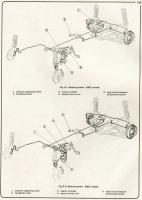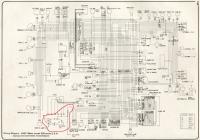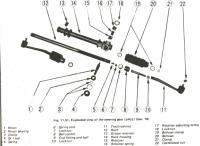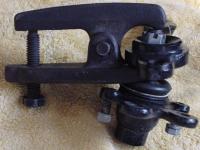Everything posted by Nissanman
-
Dead Dome Light
As indicated, the door switches when released [door opened] apply an earth to the wire that heads of to the dome light. The fact that you found and replaced a ruptured fuse indicates there may be an intermittant short in the wiring somewhere. Not sure what the wide connector is that you refer to, but when the door switch operates, you should see a healthy earth at one side of the globe. If the supply is good, then the globe should light. Remember the wise words of the Dahlai Lama: - "There are only two types of electrical faults, open circuits and short circuits":cheeky:
-
Brake warning light on after alternator upgrade
If you can post a diagram of what the relay configuration is, I'm sure we can adapt a conventional automotive relay to perform the function. Nissan is/was notorious for using weird arse relay configs. and pinouts, I avoid using their relays like the plague. If an over the shelf Bosch/Narva accessory relay will do it, it may be well worth fitting a conventional relay socket, especially since the OEM replacement is NLA:rolleyes:
-
Steam Cleaning ... opinons please ...
Usually YES. Therein lies a problem. Any high pressure cleaning method will find any holes and if you are real unfortunate, create some new ones:rolleyes: If you can, try before you buy. Personally I would hire a device and, as has been mentioned, get the car uplifted somehow to allow reasonable access. Oh, and do the job in someone elses driveway:eek: In the past I have used a solvent attachment on my air compressor. It used surprisingly little solvent and did a reasonable job. I used kerosine as the solvent, then washed the body down with a high pressure garden hose. Either or, it will make a mess!
-
faulty new rear wheel cylinder? Brake troubleshooting...
The 240Z and 260Z had a "pressure regulating valve" and a "dual circuit pressure differential switch". They are located in different places though, see image.
-
heater switch schematic info
I have the diagram for a basic model S30 for USA, I'm guessing it will be the same. It shows a 30A inline fuse fitted to an L [bLue] wire. The fan blower switch is wired to that inline fuse as R [Red] wire. So, if you trace the single R wire back into the centre console area, it should go to that inline fuse holder. I'm guessing the fuse is Kaput:rolleyes: The inline fuse gets its' battery feed from a 20A fuse [ACC.] fitted to the main fuse block.
-
How can you pass these up?
.....and it comes with TWIN OVERHEAD SUNVISORSROFLROFLROFL
-
Floor Boards - Please give me your opinions!
Well, I think so far the concensus is to replace:nervous: Don't let that worry you. Take it from me, if that parent metal isn't perforated, it is probably very thin and trying to do any welding or patching to it will be an absolute PAIN:tapemouth I use a sharp pointed metal scribe to poke and prod at such areas. You will soon find out what the integrity of the panel is. Then it is surgically removed with your favourite angle grinder:devious::devious: Try and get the replacement floor panels before you remove the old ones though, then you can cut the old to suit. Use all of the new panel, it is not worth trying to salvage little bits of the old when you have a brand spankers new. If it turns out that you have to cut out extra, then that just means a strip or patch will need to be inserted to make up the shortfall. Just a big jigsaw really:eek::eek:
-
faulty new rear wheel cylinder? Brake troubleshooting...
Hmmmm, there is a lot there to address isn't there:rolleyes: Brake booster: is a feel good device which reduces pedal effort for braking. As a confidence check, disconnect the vacuum hose to the booster [and plug it] and see if the pedal feels any different. That might give you an indication if it is actually boostin'. BMC: can sometimes be very difficult to bleed properly. However if you don't have a spongy pedal, may be quite OK. Front pads: check what temperature range they are good at. They may very well be bit too hi-tech for normal driving. Perhaps they need a special bed in procedure too. E brake: If you have now got all new hardware, perhaps the shoes etc. have been assembled incorrectly. There is something amiss if the adjuster binds on the wheel cylinder. May be wise to carefully check the assembly with the pics. in your FSM to make sure all is well. The shoes definately have to be paired up correctly to have the mechanism work. A stretched e brake cable will make thinks a bit unresponsive as well. I'm sure you will notice a difference in the braking performance between your Z and BMW, but the Z sounds like it does have an issue somewhere:angry:
-
SODA Blasting--Is it really that good?
Yup, he and I are one of the same:D:D After all the hoo haa, I have decided to stick with garnet or similar, I won't be trying out the soda:ermm: At least I know that metal cleaned that way can be overcoated with relative ease and confidence. I'm getting a pressure pot blaster too which should be easier to use on bodywork than the syphon gun I have at the moment. http://www.supersavingsonline.net/Photos/SandBlaster/DSC02325.JPG I'm sure soda has its' applications, but preparing a car for painting doesn't appear to be one of them:finger: Now if you've got a really tall statue that was given to you by the French and it needed cleaning, well.......
-
Solutions to a shakey problem
That bit is what the Haynes Manual describes as a " Grease reservoir". I checked my rack and I just have a grease nipple there, I guess you could do the same:devious:
-
Solutions to a shakey problem
That is a bit frightening! It'll be like a new car when all that stuff is replaced:devious: Take the time to remove the steering rack when you get the new ball joints. They are fairly easy to dissemble and re-lube. Then you adjust the backlash screw to get all the slop out. It probably needs new boots as well.
-
Oil pressuse sender fix ?
You can test the gauge for response by doing the following:- lift the wire from the electrical connection on the oil pressure sender and earth it out on a convenient point. Then when you turn the ignition on, the gauge should swing to maximum. The fault is usually a sender that loses the plot and either goes erratic or dead:hurt:
-
torquing suspension after overhaul
My reference says: - Rear Suspension Transverse link outer self locking nuts 65Ft/Lb Transverse link inner bolts 115Ft/Lb Transverse link mounting brace bolt 31 Ft/Lb Transverse link outer pivot housing lock bolt 8Ft/Lb
-
Cut-off switch anyone?
I find that it is very convenient when wiring in an ignition kill switch, to put it in series with the Tachometer leads. This is for an impulse type tachometer which is what I believe the '70 uses. The BW wire from the coil + goes to the tach. loops through a transformer and exits as a GW wire. The GW wire goes back to the ignition resistor in the engine bay. All you need to do is wire a toggle switch in series with either of those two wires. Can be done in the cabin for maximum security, or in the engine bay for minimum security. If the wire tap is visible in the engine bay a thief can simply bridge the wiring and the switch is by-passed:tapemouth
-
Help! Engine won't start! Already tried some stuff
I see what you mean about vacuum now. Those open ports will be an issue when you try to drive the car, they will suck air and **** up the fuel mixture. However, at this stage, you could just plug all the manifold nipples with a short length hose with the end clamped off, that should be OK for the short term. We can sort out the final configuration of those later on. What are the actual compression readings 60psi or what??
-
Timing Chain Question
When you look at the mechanism of driving over head cams, initially a toothed rubber belt would seem easier to service, simply because it is external to the engine. However, I recently did the timing belt on my R33 Skyline [2.5L turbo] and it was far from straight forward:rolleyes: Nothing hard, just a lot of time demounting everything to get to the rubber band. And that time would cost big $$$ if you had a shop do the job. That is probably why a lot of drivers don't have it replaced at the recommended interval. And that would be why a lot of engines get munched when the rubber band breaks:dead: The oil bath chain drive also needs a lot of dissembly but it doesn't have the short service life that a belt does. The result is that, barring a catastrophe, they usually last until a major re-build is necessary, as mentioned above.
-
I cant get these parts apart!
Try and use this tool, much more friendly to you and the ball joint than a pickle fork:finger: It is excellent to use, just make sure the nut is back on the threads of the ball joint before you turn the bolt. [Just thread it on till it is flush with the top of the pin, not like what is shown in the attached pic.] It prevents the ball joint threaded shaft from mushrooming out. The advantage of this tool is the linkage doesn't need to be on the car or in a vice because no percussion instrument is used:)
-
Timing Chain Question
You already have a thread on this topic:nervous: http://www.classiczcars.com/forums/showthread.php?t=28739
-
Help! Engine won't start! Already tried some stuff
If it is 60psi per cylinder, Houston, you have a problem:rolleyes: Needs to be in the order of 180psi non-turbo and 140psi for a turbo engine. If everything else is OK, fuel in the float bowls should be enough to get it going. You won't be developing much vacuum until it actually fires up so that in itself is a non-event. If spark is not adequate, it will not fire up, so we need to look at that too.
-
Help! Engine won't start! Already tried some stuff
Pull all the plugs out and crank it over. Plug each spark plug hole in turn with a finger of your choice and it should fart nice and strong when the piston comes up on the compression stroke. Check all of the cylinders for equality as best as you can determine. If compression is weak, then things go a little pear shaped. A squirt of WD-40 into each spark plug hole would help free up any stuck bits. May take a few doses and a few days though. You may also have stuck valves in their guides. To free them up you can tap onto the top of the rockers with a little hammer to loosen up the stems. Won't hurt to dose them up with some WD-40 either. When you are happy that the engine can compress OK, you will need to check the spark etc. as mentioned. If this sucker hasn't been running for 10 years, it may need quite a lot of coaxing:nervous::nervous:
-
Timing Chain Question
Chains are longer lasting than the toothed rubber belt technology however... I would advise you to have a close look at the rubbing block on the tensioner, as well as wear from the chain on the chain guides. If these surfaces are deeply grooved by contact with the timing chain then that may mean that the chain has stretched somewhat and would be better renewed. It is wise to renew not only the worn guides, chain and tensioner but to do the upper and lower sprockets as well. Then it will all be fresh and mechanically A1. I believe Nissan as well as other Manufacturers have gone back to timing chains in lieu of rubber belts. Interesting how the "wheel" turns:rolleyes:
-
Phantom Grip ????
Not another version of Snake Oil:tapemouth
-
Sand blaster not working!
I have the pressure to the MAX, 100psi:eek: Waste of time trying to clean anything at a lesser pressure. Syphon gun in a cabinet. As mentioned, I now and then put my gloved finger over the gun outlet and pull the trigger to blow the sand back out of the pickup tube. It does clog up during use. Make sure the media you are using is as DRY as possible. You may be able to get by with "sand" but I would suggest some Garnet 40/80 mix, meant for the task:)
-
Replacing oilpan gasket
Do you have a weepy gasket now? If so, have you tried re-tightening all the fasteners to fix it? It may just be enough to repair the leak. Have a close look at the edge of the sump gasket and do a judgement as to whether it would stand a bit more compression. If you do decide to drop the sump and replace it, make sure you drain the engine oil first:finger: An alternative to raising the engine is dropping the x-member. Then you just need to support the engine at its' normal height with a skyhook and it won't stretch any of the life support systems. Loosen the x-member to body mounts and you can lower the whole front end on a trolley jack. Steering linkage and engine mounts will need to be disconnected. Just a thought:)
-
Fighting Rust...Help
There is the problem. I'm using Metal Prep as a generic term, not as what POR may specify/supply. It is essentially phosphoric acid which you dilute in clean water. It etches the surface of the metal and converts any remaining iron oxide to black iron phosphate. Probably not at all suitable to the POR process:finger: Stick to the POR list of treatments, by all means. Apologies if I confused the issue:nervous:








